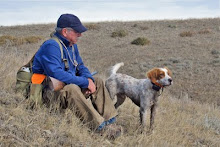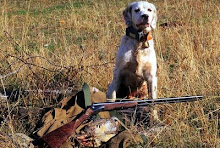I recently returned from Northeast Oregon. Returned from my hunt early - not something I would usually do.
I ran out of dog. My old dog Jesse is a little long in the tooth and I left him home to keep my wife company. Tommy is in South Carolina in training. So I took Ted and Cody, the six month old puppy. Long story short, we hunted opening weekend but by Monday Ted's foot began to swell and looked really nasty.
To the vet in Enterprise, Oregon (Jereld E. Rice, DVM). Neither of us could find a wound, but it looked a lot like a grass awn in a middle toe. Ted was fevered and the foot was red and swollen to almost twice normal size. The vet prescribed Cephalexin and Rimidyl and said it would probably take 10 days or so to heal, but to come back if I saw changes.
Two days later I let Ted out of his crate to pee, and he decided to go hunting. After Pete and I spent a couple hours looking for him, he showed up at the truck looking contrite, and without his bandage on his foot (I had found most of the bandage downhill and about a mile away earlier in the search). I cleaned his foot and flushed with saline solution and while doing so noticed an entry wound. Back to the vet, where he did some deep cleaning and removed parts of a cheat grass awn. "Give him 10 days", said the vet.
So I hunted with Pete behind his setters, Silk and Rosie and focused on running Cody every day and had a good time watching him learn about chukars and Huns. This was really the bright point of the trip.
But after suffering some back pain in the mornings, shooting poorly when I had opportunities and falling while fishing the Wenaha and ruining my digital camera, I felt I was snake bit and decided to head home to regroup and plan for hunting later in the fall when Ted's foot heals up.
I did enjoy Pete's company, we had some great campfires and ate and drank well. But even I know when to quit.
Bat News
19 hours ago








